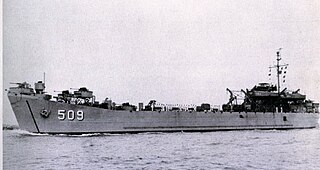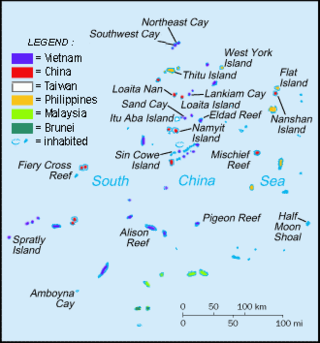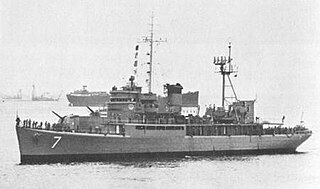Sierra Madre may refer to:

The Philippine Navy (PN) is the naval warfare service branch of the Armed Forces of the Philippines. It has an estimated strength of 24,500 active service personnel, including the 10,300-strong Philippine Marine Corps. It operates 82 combat vessels, 14 auxiliary vessels, 25 manned aircraft and 8 unmanned aerial vehicles. Tracing its roots from the Philippine Revolutionary Navy on May 20, 1898, while its modern foundations were created during the creation of the Offshore Patrol in February 9, 1939, the PN is currently responsible for naval warfare operations and maritime patrol missions within the Philippine Waters, as well as ensuring the protection of the Philippine's maritime interests, including the West Philippine Sea and Benham Rise.

USS Marion County (LST-975) was an LST-542-class tank landing ship built for the United States Navy during World War II. Like many of her class, she was not named and is properly referred to by her hull designation. She was later named after counties in seventeen U.S. states, she was the only US Naval vessel to bear the name.

USS Bulloch County (LST-509) was an LST-491-class tank landing ship built for the United States Navy during World War II. Named for Bulloch County, Georgia, she was the only U.S. Naval vessel to bear the name.

BRP Benguet (LS-507) is a LST-542-class tank landing ship currently serving the Philippine Navy.

USS Garrett County (LST-786) was an LST-542-class tank landing ship built for the United States Navy during World War II. Named after Garrett County, Maryland, she was the only U.S. Naval vessel to bear the name.

Philippines and the Spratly Islands – this article discusses the policies, activities and history of the Republic of the Philippines in the Spratly Islands from the Philippine perspective. Non-Philippine viewpoints regarding Philippine occupation of several islands are currently not included in this article.

BRP Andrés Bonifacio (PF-7) was a Philippine Navy frigate in commission from 1976 to 1985. She was one of six ex-United States Navy Barnegat-class small seaplane tenders/ex-United States Coast Guard Casco-class high endurance cutters received from the United States after the Vietnam War, two of which were acquired to supply spare parts for the other four. Andrés Bonifacio was considered the lead ship of her class in the Philippine Navy, and she and her three commissioned sister ships were the largest Philippine Navy combat ships of their time.
The BRP Gregorio del Pilar (PF-8) was an Andrés Bonifacio-class frigate of the Philippine Navy in commission from 1977 to 1990. She was one of six ex-United States Navy Barnegat-class seaplane tenders/ex-United States Coast Guard Casco-class high endurance cutters received from the United States after the Vietnam War, two of which were acquired to supply spare parts for the other four. She and her three commissioned sister ships were the largest Philippine Navy combat ships of their time.

USS Wachapreague (AGP-8) was a motor torpedo boat tender in commission in the United States Navy from 1944 to 1946, seeing service in the latter part of World War II. After her Navy decommissioning, she was in commission in the United States Coast Guard from 1946 to 1972 as the cutter USCGC McCulloch (WAVP-386), later WHEC-386, the fourth ship of the U.S. Coast Guard or its predecessor, the United States Revenue Cutter Service, to bear the name. In 1972 she was transferred to South Vietnam and served in the Republic of Vietnam Navy as the frigate RVNS Ngô Quyền (HQ-17). Upon the collapse of South Vietnam at the end of the Vietnam War in 1975, she fled to the Philippines, and she served in the Philippine Navy from 1977 to 1985 as the frigate RPSGregorio del Pilar (PF-8) and from 1987 to 1990 as BRP Gregorio del Pilar (PF-12).

The Casco class was a large class of United States Coast Guard cutters in commission from the late 1940s through the late 1980s. They saw service as weather reporting ships in the Atlantic and Pacific Oceans until the early 1970s, and some saw combat service during the Vietnam War.
Reed Tablemount is a large tablemount or guyot in the South China Sea north-east of Dangerous Ground and north-east of the Spratly Islands. It covers an area of 8,866 square kilometres (3,423 sq mi), but with depths between only 9 and 45 metres. The submerged but hydrocarbon-rich area includes Nares Bank and Marie Louise Bank.

Second Thomas Shoal, also known as Ayungin Shoal, Bãi Cỏ Mây (Vietnamese) and Rén'ài Jiāo, is a submerged reef in the Spratly Islands of the South China Sea, 105 nautical miles west of Palawan, Philippines. It is a disputed territory and claimed by several nations. The reef is occupied by Philippine Navy personnel aboard ship, the BRP Sierra Madre (LT-57), that was intentionally grounded on the reef in 1999 and has been periodically replenished since then.

BRP Gregorio del Pilar (PS-15) is the lead ship of her class of offshore patrol vessel of the Philippine Navy. She is the second ship to be named after Gregorio del Pilar, a Filipino revolutionary general known for his role at the Battle of Tirad Pass. She was originally designated as "PF-15" from 2012 to mid-2016. Then the Navy adopted a new code designation system and she was redesignated as "FF-15". In February 2019, the Navy downgraded the status of the entire class from frigate to patrol ship and redesignated her to "PS-15".

The Philippines–South Vietnam relations refers to the bilateral relations of the Republic of the Philippines and the now defunct-Republic of Vietnam. The Philippines was an ally to South Vietnam during the Vietnam War providing humanitarian aid.

On February 6, 2023, the China Coast Guard and Philippine Coast Guard had an encounter near the Second Thomas Shoal, one of the features of the Spratly Islands which is subject to a wider dispute in the South China Sea.

On August 5, 2023, a China Coast Guard ship blocked a Philippine Coast Guard ship en route to the Philippine-occupied Second Thomas Shoal in the disputed Spratly Islands.
The Atin Ito Christmas convoy is a civilian-led mission to deliver donated goods to Filipino troops stationed in the Spratly Islands, a feature claimed by several countries including the Philippines and China. The Atin Ito Coalition is an organization which supports the Philippines' sovereignty claims in the South China Sea.

















